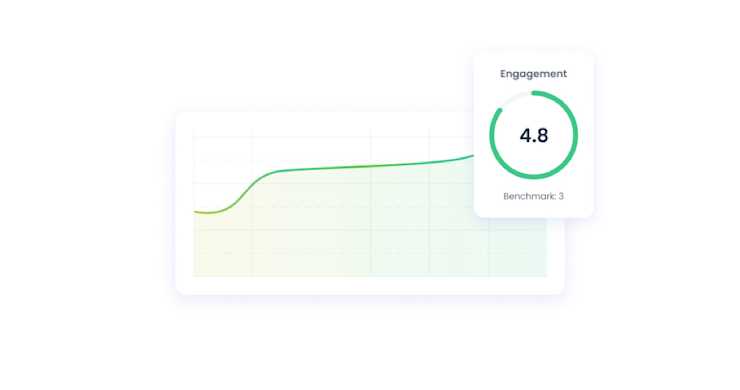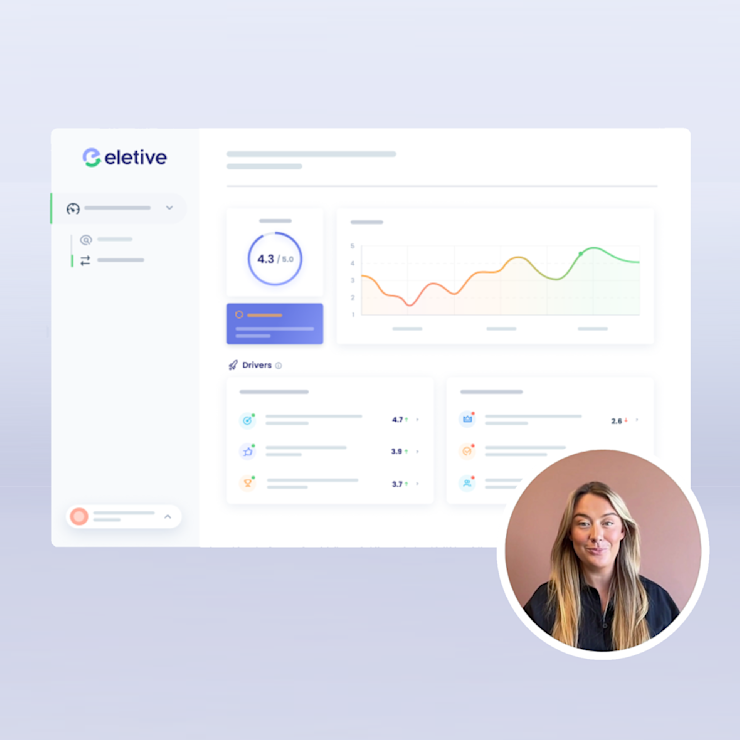Employee engagement is fundamental to a healthy and productive workplace environment. It has a direct impact on employee wellbeing and job satisfaction, as well as on overall business performance. Measuring employee engagement with regular employee pulse surveys allows you to calculate the Employee Engagement Index (EEI) in your organisation.
Calculating Employee Engagement Index is an effective way of measuring how engaged your workforce is, and how the level of engagement is developing over time. The index is also a useful tool for benchmarking. The Employee Engagement Index benchmark allows you to compare engagement levels both within your organisation and against other companies in your industry. It's also a good basis for action-planning to improve employee engagement.

What is Employee Engagement Index?
The Employee Engagement Index is based on a compilation of metrics, coming from your employee engagement surveys. By measuring the 11 most important drivers of employee engagement and compiling them, the Eletive platform calculates your Employee Engagement index for you.
The engagement index is an important tool that can help you identify areas of improvement and create strategies to increase employee engagement. It can also be used to measure the impact of employee engagement initiatives and track progress over time.
Employee Engagement Index - what are the benefits?
The Employee Engagement Index is a metric. It shows you how the people in your organisation are feeling about their employee experience. The benefits of measuring this are numerous, as it provides you with the tools to increase employee engagement in a structured and strategic way. And the benefits of high employee engagement include:
Increased employee engagement
Improved employee experience
A stronger employer brand
Increased retention
Decreased absenteeism
Less sick leave
Lower employee turnover
Improved performance
Increased job satisfaction
Improved customer experience

How to calculate Employee Engagement Index
Eletive’s standard engagement questionnaire consists of 46 questions that cover 11 different drivers of employee engagement. Together, these drivers form the basis for the Eletive Employee Engagement Index. Your organisation’s Employee Engagement Index is continuously calculated and updated based on data from dynamic pulse surveys, and dashboards and reports are updated and accessible in realtime.
Related reading: Employee engagement survey questions – what to ask and why?
The Employee Engagement Index creates an overview of the level of employee engagement in the organisation. In the Eletive platform, the EEI is calculated on organisational level, but also on segment, team and individual level. It can be used to track changes in employee engagement over time, and can it help can employers make informed decisions about how to best support their employees and create a positive work environment.
It's important to note the Employee Engagement Index formula includes 46 survey questions and all the different drivers of engagement. To fully understand the employee experience at a deeper level, it's helpful to look at the employee engagement data from different angles. The Eletive platform makes it easy and intuitive to understand and analyse the survey results, based on the different drivers, but also based on the different segments in the organisation. Reports and heatmaps are available in realtime, and can be easily be exported into Powerpoint with just click.
The drivers of employee engagement
Employee engagement is essentially the degree to which employees are actively invested in and enthusiastic about their work. It's based on multiple factors such as job satisfaction, recognition, internal communication, motivation, and team dynamics. To increase engagement levels and the sense of belonging, organisations should identify areas where employees feel unmotivated or disconnected from their work and craft strategies to address these issues.
Related reading:The drivers of employee engagement – and how to measure them
The 11 main drivers of employee engagement are measured by the science-based standard question battery in Eletive:
Feedback and communication
Autonomy
Meaningfulness and participation
Workload
Health
Workplace and tools
Learning and development
Goals and goal achievement
Strategy, vision, and culture
Relationship with manager
Relationships with colleagues
In addition to this, Eletive also offers add-on survey packages to measure other areas fundamental to employee engagement, such as:
Diversity and inclusion
ESG and sustainability
Onboarding
Offboarding
Remote work
And many more...
Measuring employee engagement with employee surveys
Sending out pulse surveys to your employees is the most effective way of measuring employee engagement. Surveys provide an opportunity for employees to provide honest feedback about their employee experience. This helps organisations identify areas where they can improve policies and create strategies for better engagement.
Surveys should be designed to capture the most important aspects of employee engagement, such as job satisfaction, job security, and recognition. Additionally, the surveys can be tailored to the specific needs of the organisation. Finally, surveys should be conducted regularly to ensure that the organisation is staying up to date with the latest trends in employee engagement.
The Impact of Employee Engagement on Business Performance
Employee engagement is closely linked to organisational performance and directly impacts bottom lines. A highly engaged workforce is more likely to produce better results for their organisation than a disengaged one. Highly engaged teams often exhibit higher levels of creativity, collaboration, loyalty, motivation, innovation, and productivity than teams who are not engaged with their work.
By gaining a deeper understanding of employee engagement through employee feedback, organisations can develop effective strategies to improve motivation and create a more engaged workforce.
Organisations can also use the Employee Engagement Index to measure the impact of their HR and engagement initiatives. By tracking the EEI over time, you can identify areas of improvement and determine the effectiveness of different initiatives. Additionally, organisations can use the EEI to compare their performance to other organisations in their industry and benchmark their engagement levels.
Conclusion
Measuring the Employee Engagement Index allows you to continuously improve engagement in your organisation. This will help you improve employee performance, as your organisation will reap the rewards of engaged employees who are proud to work for your company and who are happy to put in discretionary effort required to perform at their best.

























